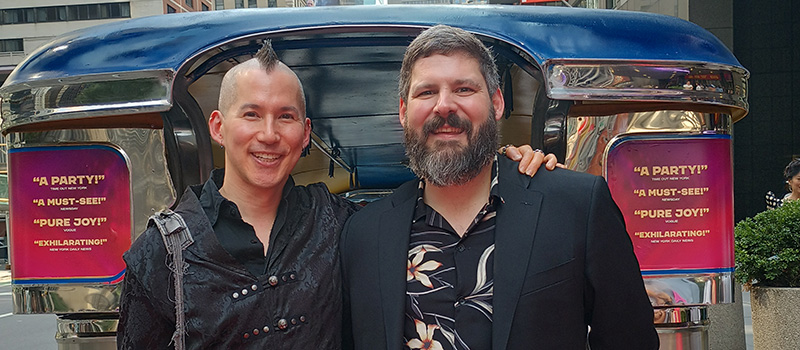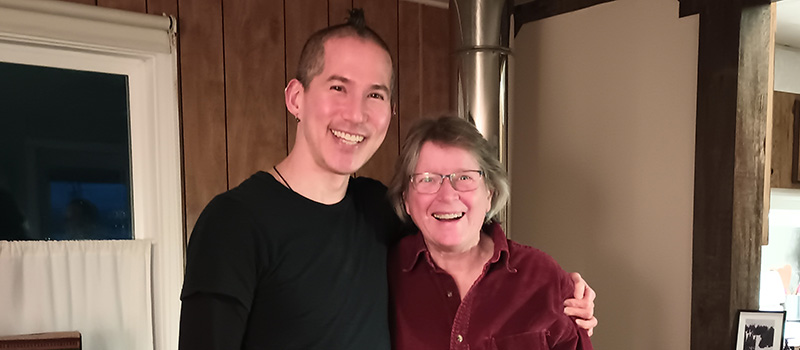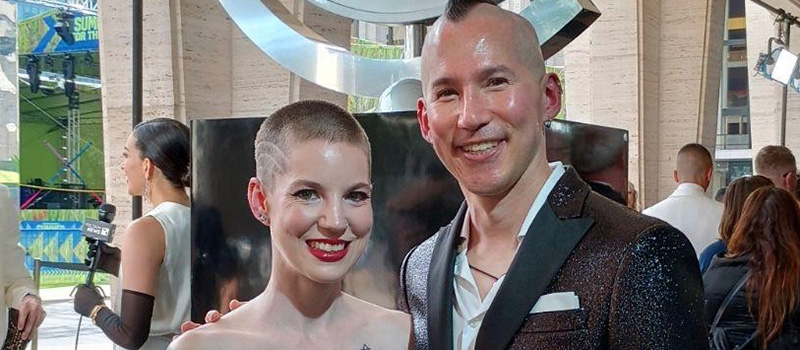1997 alumnus enjoys creating the sound effects that tell stories
October 14, 2024 — Whether it’s the pop of a champagne cork, an actor’s voice or a live band, a sound designer is responsible for nearly everything you hear at the theatre.
The sound of crickets for a nighttime scene? That’s the creation of a sound designer, who also decides where speakers are situated, where microphones are placed, and which music is used to create a mood. The sound designer (or two, if it’s a massive Broadway production) composes or creates sounds on their own and goes through sound effect libraries to mix, match, and edit effects for the stage.
“I really enjoy finding or creating the perfect sound, the perfect effect or music for whatever moment is in the play to help tell the story, both on a granular level of what’s happening at that moment, and as a broader thing addressing the world that the play is taking place in,” says M.L. Dogg ’97.
 M.L. Dogg ’97, left, is pictured with Cody Spencer on opening night of the Here Lies Love musical. The two were co-sound designers.
M.L. Dogg ’97, left, is pictured with Cody Spencer on opening night of the Here Lies Love musical. The two were co-sound designers.
While his stage name is M.L. Dogg, in person he prefers MuTTT, the moniker he’s gone by since his first day at Grinnell College. It’s a tribute to a childhood pet and his long-ago computer bulletin board handle.
For more than 25 years, MuTTT’s worked as a freelance sound designer on dozens of Broadway productions, off and off-off Broadway shows, and regional theater and international works.
This past June, MuTTT and co-sound designer Cody Spencer were nominated for a Tony Award for Best Sound Design of a Musical, Here Lies Love. “It was a big, massive show that needed two people, and it’s one of my proudest shows,” says MuTTT. David Byrne, lead singer of the former band Talking Heads, came up with the concept and music, while acclaimed DJ Fatboy Slim added beats and other music contributions.
Now based in Seattle after two decades living in New York, MuTTT is an assistant professor of sound design at the University of Washington, a job he juggles with sound design work locally and nationally. He’s currently working on The Skin of Our Teeth by Thornton Wilder at Seattle Rep. It’s a Pulitzer Prize-winning play that first opened in October 1942 that MuTTT calls incredibly topical.
 MuTTT reunited with Pip Gordon, a former Grinnell College associate professor of theatre, in Whidbey Island outside of Seattle.
MuTTT reunited with Pip Gordon, a former Grinnell College associate professor of theatre, in Whidbey Island outside of Seattle.
“It talks about an incoming ice age, refugees, an election, devastating worldwide disaster, and war,” says MuTTT, who bought a cheap bugle and taught himself to play (purposely not well), then recorded himself to help illustrate the play’s devastating, post-war landscape.
“Sound can be very specific, and also very abstract, and it’s really fun and exciting to take something, recorded or live, and make it fit that moment and help move the story along,” he says.
MuTTT developed his interest in theatre after arriving at Grinnell. During new student orientation, several theatre professors spoke about their classes to drum up awareness.
“[Former Associate Professor of Theatre] Pip Gordon, who was from New Zealand, got up there and talked about her Introduction to Stagecraft class,” MuTTT says. “In her cool Kiwi accent she said, ‘I’m going to teach you enough to be dangerous.’ I thought, ‘I like to be dangerous’ and signed up for the class.”
After one class and running crew for a College show, “the community and experience just really struck me, and I fell in love.” MuTTT took every class he could with Gordon, focusing on lighting and sound design. “She’s absolutely 100 percent responsible for me being involved in theatre,” he says. “I was never an actor. I was always focused on design and being a technician.”
 MuTTT and partner HR Montgomery stand inside the Lincoln Center for the Performing Arts in New York City for the 2024 Tony Awards on June 16.
MuTTT and partner HR Montgomery stand inside the Lincoln Center for the Performing Arts in New York City for the 2024 Tony Awards on June 16.
MuTTT was also mentored by Erik Sanning ’89, Grinnell’s technical director in the Department of Theatre, Dance, and Performance Studies. “He’s always willing to listen and advise, and in my professional world I’ve often wished that I had a technical director and collaborator that was as good as him.”
“Both Pip and Erik started in their roles at the same time that I did,” MuTTT added. “It was a magical year.”
Though MuTTT had lighting and sound design experience, he focused on sound after graduation because the field was less saturated and didn’t require a graduate degree. He got a job at Actors Theatre of Louisville (Kentucky) for a year then moved to New York. He worked in New York as a freelance sound designer for two decades, then decided he needed a more balanced life, and in 2019 moved to Seattle.
“We hear sound all the time, and we subconsciously process what it all means,” says MuTTT, explaining what draws him to his work. “But if you think about what it is that distinguishes each sound from another, it’s really fascinating to pay attention to. I like to point out to my class that as you cross a street you may not really think about how far away an approaching car is, but your brain tells you how far away it may be, how fast it’s moving, and whether or not it’s safe to step into the road. Taking that into a theatre setting, you can manipulate the audience to react how you want them to by selecting the right sound and playing it through the right speakers. This is all really fun and interesting for me.”
— by Anne Stein ’84